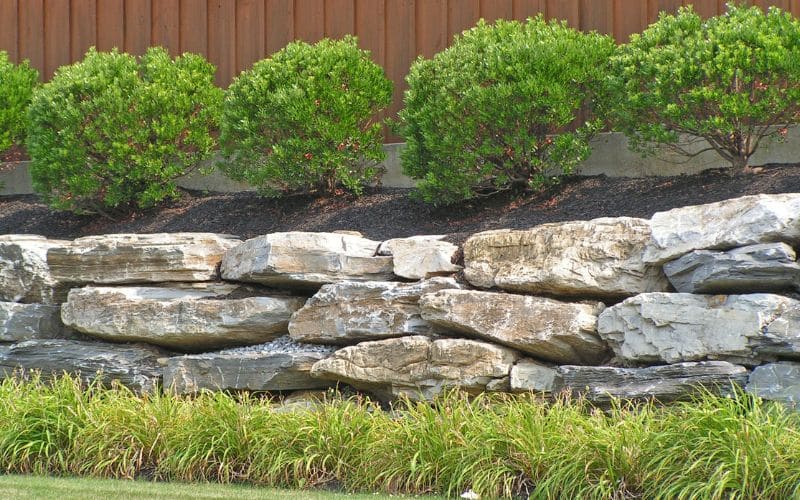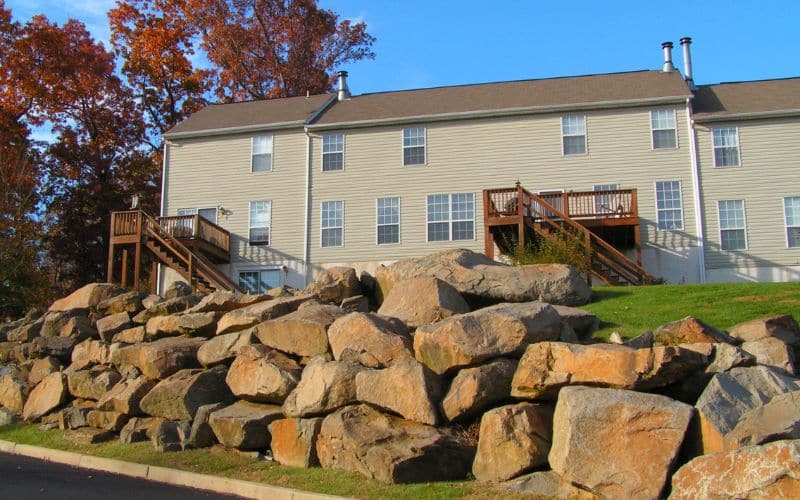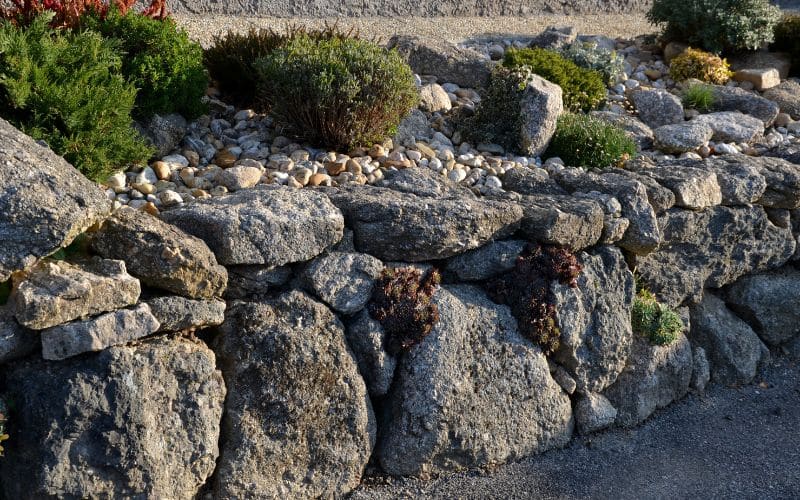
When it comes to landscaping, boulder retaining walls can be a game-changer. Not only do they add a rustic charm to your garden, but they also provide practical solutions to soil erosion and sloping land issues. However, it’s not as simple as stacking a few rocks together. There’s a science behind it, and understanding this can make the difference between a sturdy, long-lasting wall and a crumbling disaster.
If you’re considering a boulder retaining wall, it’s crucial to understand the role of the soil behind it. Sandy soils with little clay can wash through the face of the wall without a filter fabric in place. But beware, if your soil has a high clay content, that same fabric could plug up, causing the wall to bulge outward.
But don’t worry, there’s a solution even for high clay content soils. Planting the heck out of your retaining wall can act like stitching, stopping the soil from eroding and creating a stronger wall. So, whether you’re a seasoned landscaper or a DIY enthusiast, let’s delve deeper into the fascinating world of boulder retaining walls.
What are Boulder Retaining Walls?
Boulder retaining walls aren’t just about the aesthetic appeal. They’re practical, effective solutions for soil erosion and managing sloping land. Building such a wall isn’t merely stacking boulders together; there’s a science to it, a method to the madness.
Understanding the type of soil behind the wall is crucial. For instance, sandy soils can wash through the face of the wall without a filter fabric. On the other hand, soils with high clay content can cause the wall to bulge when filter fabric is used. This fabric can plug up, causing the wall to bulge outward.
So, what’s the solution for high clay content soils? The answer may surprise you – plants. Planting vegetation on the wall can prevent soil erosion and strengthen the wall. It’s almost like stitching the retaining wall together. The plants stop the soil from weeping or eroding through the face of the wall, knitting everything together to create a stronger retaining wall.
But remember, filter fabric isn’t a universal solution. You can’t just apply it and expect results. It requires careful use and understanding of the soil and conditions behind your wall.
The next time you’re considering a boulder retaining wall, take a moment to appreciate the science behind it. From the type of soil to the use of plants and filter fabric, there’s more to it than meets the eye. But with careful planning and a keen understanding of the land, you can build a wall that’s not only visually appealing but also structurally sound.
Benefits of Boulder Retaining Walls
When it comes to managing sloping land and soil erosion, boulder retaining walls are a practical choice. But beyond their practicality, these walls have a host of other benefits. They’re not only cost-effective but also aesthetically pleasing. Let’s delve deeper into the advantages of boulder retaining walls.
Erosion Control
First off, boulder retaining walls are excellent at controlling erosion. If you’re dealing with sandy soils that can wash through walls without filter fabric, a boulder wall is your solution. Even with soils that have high clay content, which can cause walls to bulge if fabric is used, boulder retaining walls stand strong. To boost erosion control, consider planting vegetation on the wall which can further prevent soil erosion and strengthen the wall.
Aesthetics
Boulder retaining walls also score high on aesthetics. They add a natural charm to your landscape. Their rugged beauty is a sight to behold, and they can blend seamlessly into any garden or yard, no matter the style. And because every boulder is unique, each wall is an original, adding character and distinction to your property.
Cost-Effective
Lastly, it’s hard to overlook the cost-effectiveness of boulder retaining walls. They’re generally cheaper than other types of walls and require less maintenance. While the initial cost of the boulders might seem high, the longevity and low upkeep of these walls make them a smart investment in the long run.
Boulder walls are durable and can withstand extreme weather conditions, making them a popular choice for homeowners. Plus, they require fewer materials and less labour for construction, further reducing costs.
As you can see, boulder retaining walls are more than just a practical solution for managing sloping land and soil erosion. They’re also an aesthetic and cost-effective choice for homeowners.
Types of Boulder Retaining Walls
Moving on from the benefits of boulder retaining walls, it’s equally essential to delve into the various types available. Each type serves a unique purpose, with specific advantages aligned to different needs and landscape conditions. Understanding these types helps you choose the right boulder retaining wall to enhance your property’s curb appeal.
Dry Stack Walls
Dry stack walls are the simplest form of boulder retaining walls. As the name suggests, this type involves stacking boulders without any mortar to bind them together. The stability of these walls relies on the gravity and the friction between the boulders. It’s an excellent option if you’re looking for a natural, rustic appearance.
However, there are a few factors to consider:
- Dry stack walls work best with large boulders. The weight of the rocks adds stability.
- They are ideal for mild slopes, as steep slopes may exert too much pressure.
- Proper installation is crucial to prevent the wall from toppling over.
Mortared Walls
On the other hand, mortared walls are a more robust and durable option. These walls use a mixture of cement, sand, and lime to bind the boulders together. The mortar makes the wall stronger, enabling it to withstand higher loads and steeper slopes.
But remember:
- Mortared walls require a sturdy foundation to support the weight.
- Drainage is key. Without a good drainage system, water can weaken the mortar and damage the wall.
- They offer a refined, sophisticated look that’s perfect for formal landscapes.
Reinforced Walls
Lastly, reinforced walls are the strongest type of boulder retaining walls. They use steel reinforcement bars (rebars) embedded into the concrete footing. These walls are perfect for handling heavy loads and extreme slopes.
Yet, there are things to note:
- Reinforced walls are more complex and costlier to build.
- They require professional installation to ensure the rebars are appropriately placed.
- Despite the cost, the added strength and durability make reinforced walls a worthy investment.
In your quest to find the right boulder retaining wall, consider your landscape’s needs, your aesthetic preference, and your budget. Each type has its unique charm and functionality. Whether you want the natural allure of dry stack walls, the strength of mortared walls, or the resilience of reinforced walls, there’s a boulder retaining wall that’s just right for your property.

Factors to Consider when Building a Boulder Retaining Wall
Building a boulder retaining wall requires careful planning and consideration. You’ll need to take into account several factors to ensure that your wall not only looks great but also serves its purpose effectively. Here are the key aspects you’ll need to consider:
Site Evaluation
Before you even begin thinking about the type of retaining wall you want, it’s important to assess your site thoroughly. Soil type, slope, and drainage all play a crucial part in the effectiveness of your wall. For instance, if you’re dealing with heavy clay or sandy soil, you’ll need to ensure that your wall is strong enough to resist the pressure exerted by the soil. You’ll also need to consider the slope of your land. A steep slope might require a more robust wall type, like a reinforced boulder retaining wall.
Drainage
Proper drainage is a must for any retaining wall. Without it, water can build up behind the wall, putting unnecessary pressure on it and potentially causing it to fail. When designing your boulder retaining wall, make sure to include a suitable drainage system. This might mean using gravel backfill and a perforated pipe or installing weep holes to allow water to escape. It’s also a good idea to slope the ground away from the wall to help direct water away.
Wall Height and Slope
The height of your boulder retaining wall and the slope of the ground it’s built on are two more factors to consider. These factors directly impact the wall’s stability. As a rule of thumb, the steeper the slope or the taller the wall, the more reinforcement it’ll need. If your wall exceeds a certain height – usually around 1.2 metres – you might also need to obtain a building permit, so it’s worth checking with your local council.
In the end, building a boulder retaining wall is no small task. It requires careful planning, the right materials, and often a bit of professional guidance. But with the right approach, it can add both functionality and beauty to your landscape.
Remember, your retaining wall is not just a decorative feature – it’s a functional part of your landscape. So, take the time to plan it out properly, and you’ll end up with a wall that’s built to last.
Steps to Building a Boulder Retaining Wall
Building a boulder retaining wall can be a rewarding project. It not only improves the aesthetics of your property but also adds functionality. Here is a simple guide to help you build your own boulder retaining wall.
Clearing the Site
Before you start building, you’ve got to prepare the site. Remove any vegetation, rocks, or debris that could interfere with the construction process. This also includes removing any topsoil, as it’s not stable enough to support your wall. Ensure the ground is level and compact, providing a strong foundation for your wall.
Preparation
Once the site is clear, it’s time to prepare for the actual construction. This involves digging a trench for the base of your wall. The depth will depend on the height of your wall. A good rule of thumb is to dig a trench that’s about one-third to half the height of your planned wall. Don’t forget to account for drainage – installing a perforated pipe at the base will ensure water can escape, preventing any damage to your wall.
Placement and Arrangement of Boulders
Now you’re ready to start placing your boulders. Start with the largest boulders at the base and work your way up with smaller ones. The boulders should be tightly packed together, with the flattest side facing outwards. This will give the wall stability and a pleasing appearance.
Backfilling and Compacting
After you’ve placed your boulders, it’s time to backfill. This is the process of filling in the gaps between your boulders with soil. Compact the soil as you go to give the wall additional stability. Be sure to fill in all the spaces – leaving gaps could compromise the integrity of your wall.
Finishing Touches
With your wall built and backfilled, you’re nearly done. To finish off, you can add a layer of topsoil and plant some vegetation. This not only looks great, but it also helps prevent erosion. Remember, the best plants for a retaining wall are those that have strong roots but don’t grow too big.
Building a boulder retaining wall is a major project, but with careful planning and a bit of hard work, it’s certainly achievable. Just remember to take your time, do your research, and don’t be afraid to ask for help if you need it.

Maintenance and Repair of Boulder Retaining Walls
When it comes to boulder retaining walls, maintenance and repairs are crucial. Like any other structure, these walls require regular upkeep to ensure they remain robust, aesthetically pleasing, and able to effectively control soil erosion.
Inspect Regularly
Regular inspections play a vital role in the upkeep of boulder retaining walls. It’s best to carry out inspections at least once a year, or even more frequently in areas subject to heavy rainfall or rapid changes in weather conditions. Look out for signs of damage such as cracks, loose stones, or areas where the ground has begun to shift. Early detection of these issues can save you both time and money in the long run.
Repairing Cracks and Loose Stones
If you’ve discovered cracks or loose stones during your inspection, it’s time to carry out some repairs. Small cracks can usually be filled in with mortar, whilst larger cracks may require professional intervention. Loose stones are a more common issue, but can often be fixed by simply resetting the stone in its place or using a small amount of mortar for extra stability. Remember, do not ignore these issues – if left untreated, they can lead to more serious structural problems down the line.
Cleaning and Removing Debris
Routine cleaning is another essential aspect of boulder retaining wall maintenance. Over time, leaves, dirt, and other debris can accumulate on your wall, potentially leading to issues such as mould growth or water damage. Regularly removing this debris can help maintain the wall’s durability and visual appeal. Use a stiff brush to remove loose dirt and rinse the wall with a garden hose. For tougher stains, a mild detergent or pressure washer may be necessary.
Conclusion
So, you’ve learnt that boulder retaining walls aren’t just about the initial build. They’re about the ongoing care and attention you give them. Regular check-ups are key, keeping an eye out for any damage like cracks or loose stones. Don’t forget, cracks are easily fixed with a bit of mortar, and loose stones can be reset or secured in the same way. And remember, routine cleaning isn’t just for aesthetics, it’s vital for maintaining your wall’s durability. By sticking to these maintenance and repair tips, you’ll ensure your boulder retaining wall stands the test of time.








